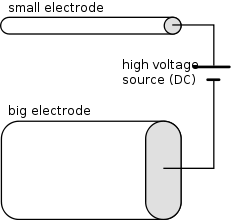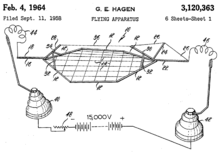Biefeld–Brown effect
The Biefeld–Brown effect is an electrical effect that produces an ionic wind that transfers its momentum to surrounding neutral particles. The effect was named by inventor Thomas Townsend Brown who claimed that he did a series of experiments with professor of astronomy Paul Alfred Biefeld, a former teacher of Brown who Brown claimed was his mentor and co-experimenter at Denison University in Ohio.[1][2] The phenomenon was also given the name "electrogravitics" by Brown based on his belief this was an electricity/gravity phenomenon. The effect is more widely referred to as electrohydrodynamics (EHD) or sometimes electro-fluid-dynamics, a counterpart to the well-known magnetohydrodynamics. Extensive research was performed during the 1950s and 1960s on the use of this electric propulsion effect during the publicized era of the United States gravity control propulsion research (1955–1974).
There is renewed focus on the Biefield–Brown effect with the spread in interest in high-voltage powered experimental flying devices known as ionocraft or lifters.
Effect analysis

The effect is generally believed to rely on corona discharge, which allows air molecules to become ionized near sharp points and edges. Usually, two electrodes are used with a high voltage between them, ranging from a few kilovolts and up to megavolt levels, where one electrode is small or sharp, and the other larger and smoother. The most effective distance between electrodes occurs at an electric potential gradient of about 10 kV/cm, which is just below the nominal breakdown voltage of air between two sharp points, at a current density level usually referred to as the saturated corona current condition. This creates a high field gradient around the smaller, positively charged electrode. Around this electrode, ionization occurs, that is, electrons are stripped from the atoms in the surrounding medium; they are literally pulled right off by the electrode's charge.
This leaves a cloud of positively charged ions in the medium, which are attracted to the negative smooth electrode by Coulomb's Law, where they are neutralized again. This produces an equally scaled opposing force in the lower electrode. This effect can be used for propulsion (see EHD thruster), fluid pumps and recently also in EHD cooling systems. The velocity achievable by such setups is limited by the momentum achievable by the ionized air, which is reduced by ion impact with neutral air. A theoretical derivation of this force has been proposed (see the external links below).
However, this effect works using either polarity for the electrodes: the small or thin electrode can be either positive or negative, and the larger electrode must have the opposite polarity.[3] On many experimental sites it is reported that the thrust effect of a lifter is actually a bit stronger when the small electrode is the positive one.[4] This is possibly an effect of the differences between the ionization energy and electron affinity energy of the constituent parts of air; thus the ease of which ions are created at the 'sharp' electrode.
As air pressure is removed from the system, several effects combine to reduce the force and momentum available to the system. The number of air molecules around the ionizing electrode is reduced, decreasing the quantity of ionized particles. At the same time, the number of impacts between ionized and neutral particles is reduced. Whether this increases or decreases the maximum momentum of the ionized air is not typically measured, although the force acting upon the electrodes reduces, until the glow discharge region is entered. The reduction in force is also a product of the reducing breakdown voltage of air, as a lower potential must be applied between the electrodes, thereby reducing the force dictated by Coulomb's Law.
During the glow discharge region, the air becomes a conductor. Though the applied voltage and current will propagate at nearly the speed of light, the movement of the conductors themselves is almost negligible. This leads to a Coulomb force and change of momentum so small as to be zero.
Below the glow discharge region, the breakdown voltage increases again, whilst the number of potential ions decreases, and the chance of impact lowers. Experiments have been conducted and found to both prove and disprove a force at very low pressure. It is likely that the reason for this is that at very low pressures, only experiments which used very large voltages produced positive results, as a product of a greater chance of ionization of the extremely limited number of available air molecules, and a greater force from each ion from Coulomb's Law; experiments which used lower voltages have a lower chance of ionization and a lower force per ion. Common to positive results is that the force observed is small in comparison to experiments conducted at standard pressure. This is likely to be the result of the massively reduced number of ions produced by the experiment, although this could also be interpreted to be a different force entirely.
Electrogravity
At one time, Brown believed his devices produced a new field that interacted with the Earth's gravitational pull, a phenomenon he labeled electrogravitics. Several researchers claim that conventional physics cannot adequately explain the phenomenon.[5] The effect has become something of a cause célèbre in the UFO community, where it is seen as an example of something much more exotic than electrokinetics. Charles Berlitz devoted an entire chapter of his book The Philadelphia Experiment to a retelling of Brown's early work with the effect, implying he had discovered a new electrogravity effect and that it was being used by UFOs. Today, the Internet is filled with sites devoted to this interpretation of the effect.
There has been follow-ups on the claims that this propulsive force can be produced in a full vacuum, meaning it is an unknown anti-gravity force, and not just the more well known ion wind, with several researchers (R. L. Talley in a 1990 US Air Force study, NASA scientist Jonathan Campbell in a 2003 experiment,[6] and Martin Tajmar in a 2004 paper[7]) finding that no thrust could be observed in a vacuum, consistent with the phenomenon of ion wind. Campbell pointed out to a Wired magazine reporter that creating a true vacuum similar to space for the test requires tens of thousands of dollars in equipment.
Patents

T. T. Brown was granted a number of patents on his discovery:
- GB300311 — A method of and an apparatus or machine for producing force or motion (accepted 1928-11-15)
- U.S. Patent 1,974,483 — Electrostatic motor (1934-09-25)
- U.S. Patent 2,949,550 — Electrokinetic apparatus (1960-08-16)
- U.S. Patent 3,018,394 — Electrokinetic transducer (1962-01-23)
- U.S. Patent 3,022,430 — Electrokinetic generator (1962-02-20)
- U.S. Patent 3,187,206 — Electrokinetic apparatus (1965-06-01)
- U.S. Patent 3,196,296 — Electric generator (1965-07-20)
Historically, numerous patents have been granted for various applications of the effect, from electrostatic dust precipitation, to air ionizers, and also for flight. A particularly notable patent — U.S. Patent 3,120,363 — was granted to G.E. Hagen in 1964, for apparatus more or less identical to the later so-called 'lifter' devices. Other ionic US patents of interest: 2022465, 2182751, 2282401, 2295152, 2460175, 2636664, 2765975, 3071705, 3177654, 3223038, 3120363, 3130945
References
- ↑ The present day Denison University claims they have no record of such experiments being carried out, or of any association between Brown and Biefeld.Paul Schatzkin, Defying Gravity: The Parallel Universe of T. Townsend Brown, 2005-2006-2007-2008 - Tanglewood Books, Chapter 13: Notes from the Rabbit Hole #3: "He Made Things Up" (online excerpts)
- ↑ alienscientist.com, Biefeld-Brown Effect Controversy, Tajmar ESA Experiments
- ↑ NASA CR-2004-213312 Asymmetrical Capacitors for propulsion
- ↑ Bahder, TB. "Force on an Asymmetric Capacitor" (PDF). Retrieved 9 October 2011.
- ↑ Mallove, Eugene (September–October 2002). "The "Lifter" Phenomenon". Infinite Energy.
- ↑ Thompson, Clive (August 2003). "The Antigravity Underground". Wired Magazine.
- ↑ Tajmar, M. (2004). "Biefeld-Brown Effect: Misinterpretation of Corona Wind Phenomena". AIAA Journal. 42 (2): 315. Bibcode:2004AIAAJ..42..315T. doi:10.2514/1.9095.
- Tajmar, M. (2004). "Biefeld-Brown Effect: Misinterpretation of Corona Wind Phenomena". AIAA Journal. 42 (2): 315. Bibcode:2004AIAAJ..42..315T. doi:10.2514/1.9095.
- Buehler D.R., Journal of Space Mixing, April 2004, vol. 2, pp. 1–22, "Exploratory Research on the Phenomenon of the Movement of High Voltage Capacitors". Space-mixing-theory.com. Retrieved 2010-09-14.
- Vassilatos G. (2000). Lost Science. Adventures Unlimited Press. ISBN 0-932813-75-5.
- Paul A. LaViolette, Ph.D. (2008). Secrets of Antigravity Propulsion: Tesla, UFO's and Classified Aerospace Technology. Rochester, Vermont: Bear & Company. pp. 84–85, 89. ISBN 978-159143078-0.
External links
- Defying Gravity: The Parallel Universe of T. Townsend Brown – authorized biography on T. Townsend Brown
- The Hunt for Zero Point – book by Jane's Aviation editor Nick Cook
- – Video of the effect
Biefeld Brown effect electrohydrodynamics
- Blaze Labs Research: What is an EHD thruster? — Introduction on EHD thrusters, ionocrafts, lifters and lots of related information
- NASA: Asymmetrical Capacitors for Propulsion (PDF)
- Army Research Laboratory, Thomas B. Bahder:Force on an Asymmetric Capacitor